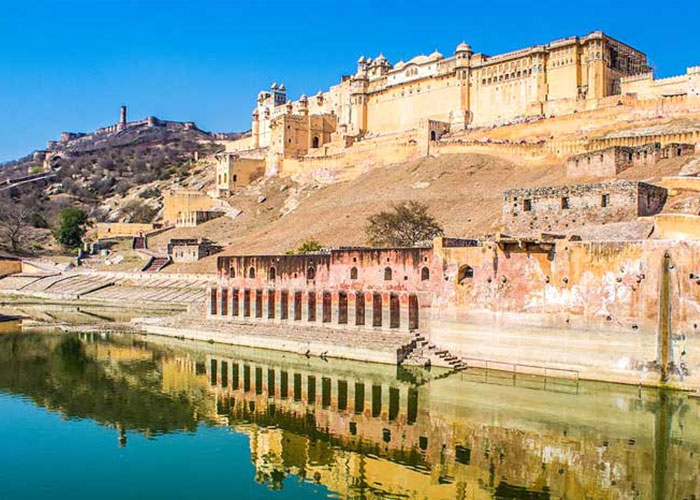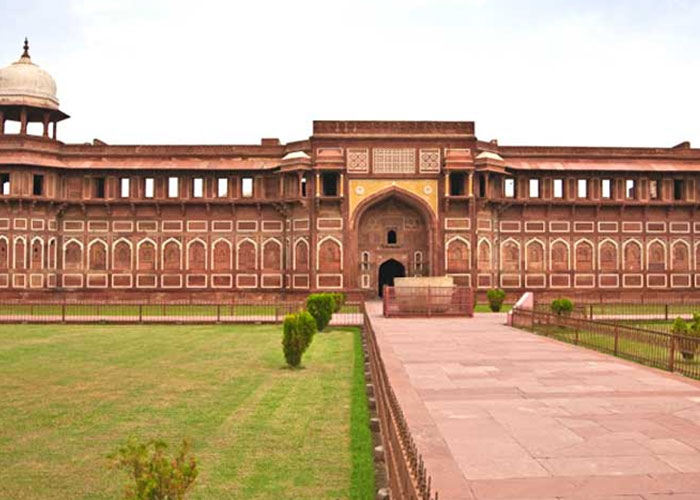Golden Quadrangle
Delhi, Agra, Jaipur & Ranthambore
5 Nights / 6 Days
Itinerary
Today arrive at Jaipur and transfer to your hotel.
The capital of Rajasthan Jaipur – popularly known as the “Pink City” as the Pink sandstone was used to construct the buildings in the old walled city. Jaipur owes it’s name, it” foundation and it’s planning to the Great-Warrior-Astronomer Maharaja Jai Singh II(1699–1744 AD). Jaipur (City of Victory) was founded by Maharaja Sawai Jai Singh II in 1727. It is the only city in the world symbolising the nine divisions of the Universe through nine rectangular sectors sub-dividing it. The architect who formalised the city’s plans on the Shilpa Shastra, the epic Hindu treatise on architecture, mixed it with the sublimity of the Mughal and Jain influences of those times. The city was painted pink in 1853 in honour of the visit by Prince Albert. Except for the busy traffic of bicycles, cars, and buses, little seems to have changed.
Overnight at Hotel
After breakfast proceed for full day city tour of Jaipur – visiting Amer Fort located at a distance
of 11 kilometres from Jaipur and was the old fort of the Kachhwaha clan of Amber.It used to be the capital, till it was moved to Jaipur. The fort is built with white marble and red sandstone and looks even more attractive because of the Maota Lake in the foreground. The fort in itself is a beautiful sight to behold but as one looks on the fort with its clear reflectionon the lake in the front; one cannot help but wonder if it is a dream or a beautiful illusion. An elephant [Subject to availability
/alternatively by jeep] will spare you the trouble of climbing up to the fortress. Once on top, stroll through the sprawling complex of courtyards and halls with a well informed and well spoken guide who would regale you with tales of yore.
Later visit the City of Jaipur. Among the highlights to be seen while touring Jaipur include the City Palace, which is an overwhelming complex of exquisite palaces, gardens and courtyards, decorative art and carved doorways. The palace museum houses collections of rare manuscripts, armours, costumes, carpets and miniature paintings. Walk to the adjacent Jantar Mantar or Astronomical Observatory made by the Maharaja of Jaipur, built in 1726 and is one of the five such astronomical wonders built by Sawai Jai Singh and makes accurate predictions even to this day. Jaipur is shopper’s paradise. Most of the bazaars are in an old city with a wide range of things to buy, from jewellery (precious and semi- precious stones and handcrafted silver) to textiles to handicrafts and antiques. No doubt, for an avid shopper “Jaipur” is the choicest of the city to shop and collect memorabilia.
Overnight at Hotel
After breakfast drive to Ranthambore; Arrive Ranthambore and transfer to your hotel.The park is one of the finest tiger reserves in the country where more visitors spending a couple of nights are likely to spot one of these majestic animals, THE ROYAL BENGAL TIGERS. Once, private tiger reserve of the Maharaja of Jaipur, in 1972 the sanctuary cameunder the Project Tiger scheme.It covers 410 sq. km and runs from the easternmost spur of the Aravalli to the Vindhya Range. It has both the old fort and the wildlife sanctuary, also known as Sawai Madhopur, after the town, which has some Jain temples with gilded paintings. Apart from tiger you cansee herds of Chital and Sambar deer and sounders of wild boar, Nilgai antelope andChinkara gazelles. There is also sloth bear, a few leopards and crocodiles. Extensive bird life includes spur fowl, jungle fowl, patridges, quails, crested serpent eagle, woodpeckers, flycatchers etc. There are also water birds like storks, ducks and geese at the lakes and waterholes. Afternoon Game Drive [Not included in the quote] to Ranthambore National Park.
Overnight at Hotel
Early morning Game Drive [Not included in the quote] into the Park where your naturalist will talk to you about the wildlife found in this Park. Ranthambhore National Park is probably the best place in the world to see wild tigers and is the only dry deciduous tiger habitat in the world. In game drive your naturalist will help you explore the park in the search of The Royal Bengal Tiger.
After Game Drive, return to the hotel for breakfast. Later drive to Agra enroute visiting Fatehpur Sikri- the deserted red sandstone city was built by the Great Mughal Emperor, Akbar, as his capital and palace in the late 16th century. It was abandoned soon after it was built when the local wells went dry and it remains today in much the same condition that itwas over 300 years ago. It is complete with palaces and mosques and used to be a townlarger than London when it was originally constructed. Now it is an extraordinary place to wander around with its buildings in near perfect condition. Later continue drive to Agra. Arrive Agra and transfer to your hotel.
Agra came into limelight during the rule of Afghan King Sikandar Lodhi – who had made it the capital of his empire. Later in 1526 A.D., the Mughal Emperor Babar took upon himself the task for rendering Agra, a unique character and beauty of its own. Agra – in terms of ambiance is still associated with its Mughal period. The Mughals besides being great rulers were also great builders and they preserved their best architectural wonders for Agra & its neighbourhood. It has many wonderful monuments and the Taj Mahal, the greatest of the mall, is a masterpiece of Mughal architecture at its best.
Overnight at Hotel
After breakfast proceed for half day city tour of Agra. The Taj Mahal (closed on Friday) – The Taj Mahal is everything that has been said about it and more. Built by the Mughal Emperor Shah Jahan as an expression of his love for his wife Mumtaz Mahal, in mid-17th century, the Taj Mahal is truly one of the wonders of the world. Though the Taj appears to be amazingly perfect from almost any angle, it is the close-up marble inlay work, which is really astounding.
Later visit The Agra Fort, an outstanding example of Mughal architecture. Agra Fort – the seat and the stronghold of the Mughal Empire under successive generations. This was the seat of Mughal rule. Shahjahan added the impressive quarters and the mosque while Aurangzeb added the outer ramparts. Visit its Hall of Public Audience and its Royal Pavilions. Besides the historical monuments, one can also explore Agra’s rich heritage of handicrafts in its markets.
Also visit Itmad ud Daula -This tomb was built in 1622 for Ghiyas Beg, father of Empress Noor-Jahan, the wife of Emperor Jahangir. It is beautifully conceived in white marble, mosaic and lattice and set a precedent as the first Mughal building to be faced with white marble in laid with contrasting stones. Sometimes also called ‘Baby Taj’, it is small, intimate and has a gentle serenity. Later drive to Delhi; arrive Delhi and transfer to your hotel. India’s capital and a major gateway to the country,
contemporary Delhi is a bustling metropolis, which successfully combines in its folds – the ancient with the modern. Amidst the fast spiralling skyscrapers the remnants of a bygone time in the form of its many monuments stand as silent reminders to the region’s ancient legacy. The first impressions for any visitor traveling in from the airport are of a spacious, garden city, tree-lined with a number of beautiful parks.
Overnight at Hotel
After breakfast proceed for tour of Old and New Delhi. Old Delhi, the Mughal Capital of Shahjahanabad. Visit the Jama Masjid which is the principal mosque of Old Delhi in India . Commissioned by the Mughal Emperor Shah Jahan , builder of the Taj Mahal , and completed in the year 1656 AD, it is the largest and best-known mosque in India. It lies at the origin of a very busy central street of Old Delhi , the Chawri Bazar Road . The mosque of Friday was built from 1644 to 1658 during the reign of Shahjahan. The mosque is 80 m long and 27 m wide. The courtyard can accommodate 25,000 worshippers and occupies 408 square feet.
Later we proceed to visit Raj Ghat where Mahatma Gandhi – The Father of Nation, was cremated and drive past the Red Fort [ from outside] – the palace for Shahjahan’s new capital, Shahjahanabad, the seventh Muslim city in the Delhi site. Wander in the busy streets of the mile long Chandni Chowk, popularly called “The Silver Street”. Enjoy the ‘Cycle Rickshaw’ ride in Old Delhi. In the afternoon proceed for tour of New Delhi, which reflects the legacy the British left behind. The division between New and Old Delhi is the division between the capitals of the British and the Mughals respectively. The division in the walled city and New Delhi also marks the division in the life-styles. The walled city is all tradition where one will be able to glean a past life-style in all its facets, colours and spells. New Delhi in contrast, is a city trying to live up to the best of 21st century standards.
The tour to Imperial Delhi will start by visit to the Qutab Minar, the tallest stone tower in India. The Qutab Minar was started in 1199 AD by Qutab-ud-Din Aibak and completed by the sultan’s successor and son-in-law, Iltutmish. The building is 72.5 m high and has 379 steps from the bottom to the top. The Minar is tapering with the diameter of the base is 14.3 m while at the top floor it is 2.7 m. The Qutab Minar is still the highest stone tower as well as one of the finest Islamic structures ever raised in India.
Later visit Humayun’s Tomb, built by the widow of the second Mughal Emperor, Humayun,
it is an outstanding monument in the Indo-Persian style, a precursor of the Taj Mahal. Drive past the imposing India Gate, the Parliament building and the Rashtrapati Bhawan, the President’s residence. Later in time transfer to Delhi Airport / Railway Station to board your flight / train for onward journey to your next destination.
Included/Exclude
- 05 Nights accommodation basis at the hotel mentioned above or similar category of alternate hotels.
- Meal Plan – Daily buffet breakfast at all the hotels.
- All currently applicable taxes including service tax.
- All transfers, city tours and transport services by air conditioned All India Tourist permit vehicle as per the above itinerary.
- Road taxes, parking fee, fuel charges, interstate taxes
- MONUMENTS Entrance Fee.
- Services of English Speaking Local Guide.
- Boat Ride at Udaipur.
- Jeep Safari at Jodhpur
- Anything which is not mentioned under “INCLUDES” header.
- Optional Tours which is not mentioned in the itinerary.
- Expense of personal nature like tipping, laundry, telephone / fax calls, alcoholic
- beverages, camera/video camera fee at monuments, medical expenses, airport
- departure tax etc.
- International or Domestic airfare / Train Fare
- Any expenses caused by reasons beyond our control such as road blocks, accidents & any medical evacuations.
- Any train delays, or re-scheduling etc.
- Any Visa fees, insurance fees, etc
- Any tips to hotel staff, local guides, drivers etc.
- Any meals apart from the ones mentioned above.
- Any expenses apart from the ones above.
- Any other services not mentioned in the inclusions
Notes
- Hindavi Tourism Terms and Conditions apply.
- Package rates are not valid during long weekends, festive period, peak period and blackout dates.
- Mandatory meal supplement for Christmas, New Year’s Eve Gala Dinner will be charged extra.
- The hotel confirmed will be as per the brochure or an alternate hotel of similar category.
- It is mandatory to carry a valid photo identity card (Passport / Driving Licence / Voter ID card).



